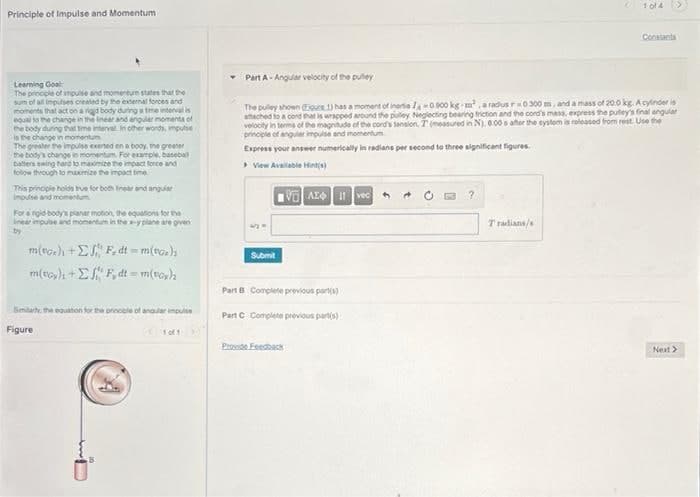The pulley shown (Egure 1) has a moment of inertia /-0.900 kg-m², a radusr-0300 m, and a mass of 20.0 kg. A cylinder is attached to a cord that is wrapped around the pulley Neglecting bearing friction and the cond's mass, express the pulley's final angular velocity in terms of the magnitude of the cord's fansion, T(measured in N), 6.00 s after the system is released from rest. Use the principle of angular impulse and momentum. Express your answer numerically in radians per second to three significant figures. View Available Hint(s) VAE Ivec ΑΣΦ C ? Tradians/s
The pulley shown (Egure 1) has a moment of inertia /-0.900 kg-m², a radusr-0300 m, and a mass of 20.0 kg. A cylinder is attached to a cord that is wrapped around the pulley Neglecting bearing friction and the cond's mass, express the pulley's final angular velocity in terms of the magnitude of the cord's fansion, T(measured in N), 6.00 s after the system is released from rest. Use the principle of angular impulse and momentum. Express your answer numerically in radians per second to three significant figures. View Available Hint(s) VAE Ivec ΑΣΦ C ? Tradians/s
Related questions
Question

Transcribed Image Text:Principle of Impulse and Momentum
Learning Goal
The principle of impulse and momenturn states that the
sum of all impulses created by the external forces and
moments that act on a rigid body during a time interval is
equal to the change in the linear and angular momenta of
the body during that time interval in other words, impulse
is the change in momentum
The greater the impulse exerted on a body, the greater
the body's change in momentum. For example, basebal
Datters swing hard to maximize the impact force and
follow through to maximize the impact time
This principle holds true for both Inear and angular
impulse and momentum
For a rigid-body's planer motion, the equations for the
linear impulse and momentum in the s-y plane are given
by
m(tor) + F, dt = m(voz),
m(t) +EF, dt = m(voy)
Similarly, the equation for the principle of angular impulse
Figure
1 of 1
Submit
Part A-Angular velocity of the pulley
The pulley shown Egure 1) has a moment of inertia /-0.900 kg-m², a radus r-0300 m, and a mass of 20.0 kg. Acylinder is
attached to a cord that is wrapped around the pulley Neglecting bearing friction and the cord's mass, express the pulley's final angular
velocity in terms of the magnitude of the cord's sansion, T(measured in N), 6.00 s after the system is released from rest. Use the
principle of angular impulse and momentum
Express your answer numerically in radians per second to three significant figures.
> View Available Hint(s)
VAE Ivec
Part B Complete previous part(s)
Part C Complete previous part(s)
Provide Feedback
?
1014
Tradians/s
Constants
Next >
Expert Solution
This question has been solved!
Explore an expertly crafted, step-by-step solution for a thorough understanding of key concepts.
Step by step
Solved in 2 steps
